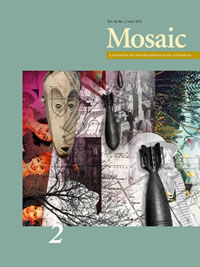Issue 46.2
Overview

General Issue
Published: June 2013
View the issue introduction or see the issue summary and contents below.
10 essays, totalling 192 pages
$21.95 CAD
Ranging across such topics as autism, melancholia, race, speculative fiction, the city, the popular periodical, realism, and (self-) representation, this ten-essay issue engages the work of a number of thinkers, artists, and writers, including Eric-Emmanuel Schmitt, Marilynne Robinson, Kenneth Millard, Edith Wharton, Lawrence Durrell, Adolf Loos, Josephine Baker, Orhan Pamuk, Ted Blodgett, and Jacques Brault.
Possibles: Of Blodgett/BraultMustapha Marrouchi This essay reflects on a consciousness that is deeply concerned about the ecosystem. Better still, it finds evidence of an eco-poetic grounding in spatial practices that challenge the very nature of space as defined by philosophy. | |
Hiding in Plain Sight: Problems of Modernist Self-Representation in the Encounter between Adolf Loos and Josephine BakerChristina Svendsen Modernist Adolf Loos designed a house for Josephine Baker that she refused to build. This encounter, and a series of Baker “memoirs” authored by other people, form the basis for a reconsideration of her artistry as well as the role of primitivism and performance art in the development of modernism. | |
Living in Different Universes: Autism and Race in Robinson’s Gilead and HomeSusan Petit Using research and theory from sociology, social psychology, disability studies, and psychiatry, this essay argues that Jack Boughton in Marilynne Robinson’s novels Gilead and Home exhibits autism spectrum disorder, and, further, that the way society has turned his impairment into a disability represents the action of white racism on many African Americans. | |
The City and its Ontology in Lawrence Durrell’s Alexandria QuartetRay Morrison Durrell situates his version of Alexandria on a cosmogonic site as limned by Lao-tzu and Chuang-tzu. For more than twenty years, Durrell had been studying these Taoist philosophers whose ontological views opened new doors for him so that he could write about the self in the way he wished. | |
The Uses of Genre and the Classification of Speculative FictionR.B. Gill Optimally, a definition of speculative fiction will promote interpretation by suggesting affinities with similar explorations of human imagination and values. The looseness of the category provides opportunity for examination of varieties of classification and uses of genre. | |
Bearing Witness: Edith Wharton’s The Book of the HomelessSusan Goodman During World War I, Edith Wharton edited The Book of the Homeless, a propagandist effort for the Allies. Designed to raise money and spur American intervention, it influenced the course of her fiction throughout the 1920s. | |
Cautionary Whales? Adolescence and Genre in Juno and PushRachael McLennan By way of exploring Kenneth Millard’s arguments about adolescence and genres, this essay examines representations of the pregnant adolescent. It also considers Millard’s claims of the possibilities of social change effected by both novels and adolescents and argues that metaphor is central to constructions of adolescence in American culture. | |
Realism and the Discursive Dynamics of the Popular Periodical, 1900-1930Janet G. Casey This essay explores the material situation of literary realism within the competing articulations of real-ness characterizing the mass-disseminated periodical in the early twentieth century. Drawing on Ladies Home Journal and The Farmer’s Wife, I demonstrate the role of modern periodical structure in framing, refining, and stretching boundaries of “the real.” | |
Making the Real Appear: Schmitt’s Enigma Variations as a ‘Traversal of the Fantasy’Graham Wolfe This essay draws upon the recent work of Alenka Zupančič and Slavoj Žižek to explore Eric-Emmanuel Schmitt’s Enigma Variations. The play gives acute expression to their “Lacanian” mode of comedy, staging a “traversal of the fantasy” that gestures toward new modes of configuring the sublime and confronting the Real. | |
Melancholy and Hüzün in Orhan Pamuk’s IstanbulBanu Helvacıoglu This essay examines melancholy/hüzün in three overlapping contexts: as a historical condition of modernity, in aesthetic production, and as a cultural condition. In Pamuk’s writing, melancholizing becomes a creative device to explore European and Islamic influences on historical and aesthetic connotations of hüzün that the city holds in its essence. |